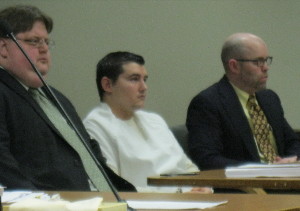By Sharyn L. Decker
Lewis County Sirens news reporter
CHEHALIS – One after another, a doctor, a judge, other elected officials and social service professionals stood up and told how an investment they support would reap multi-fold savings for taxpayers as well as reduce suffering for children, families and other individuals in Lewis County.
Their goal? To persuade the three county commissioners to implement an increase in the sales tax in the county, to help fund what’s known as drug court, a family treatment court and other measures to reduce drug and alcohol abuse and help keep mentally ill individuals stable.
The overwhelming message at a gathering last week in Chehalis was this: Untreated mental health and addiction issues are pervasive, and extraordinarily expensive as they are currently handled. And a tax increase of one-tenth of one cent could be used to deal with the problems in a more cost-efficient way.
The money arguments seemed compelling. The social costs described were heartbreaking.
Lewis County Superior Court Judge Nelson Hunt told of the savings to the criminal justice system that comes with each drug court participant, by putting a stop to repeated offenses related to ongoing drug use.
Some of their drug court members have 13, 14, even 20 prior convictions for theft-related crimes, Hunt said.
One person, one felony, one time, costs several thousand dollars, not counting the costs to the victim, he said.
Former Lewis County Superior Court Judge H. John Hall founded the local drug court in 2004. Hunt took over after Hall retired in the summer of 2007.
Of the 70 people who have graduated from drug court since its inception, only four have returned with a new felony charge, Hunt said, calling that number astounding.
While recidivism in general is between 60 percent and 65 percent, it’s much lower among drug court participants, according to an exchange between Hunt and drug court attorney Paul Dugaw.
Among those who attend drug court, recidivism is expected to be between 5 percent and 20 percent, Hunt and Dugaw said.
“Also the lives that are changed, you cannot put a value on that,” Hunt said.
Judge Hunt has been visiting city councils one by one to win their endorsements for the tax.
Hunt and drug court manager Jennifer Soper-Baker began their campaign after they were told last fall the county budget could only support drug court one more year.
But a little-known group known as the Lewis County Community Health Partnership / Network has been working for two years to get the county to take advantage of an option to increase its sales tax to fund enhanced substance abuse and mental health services and what are called therapeutic courts. Drug courts are just one kind of those.
Fifteen counties in the state have enacted it so far, according to the moderator of the March 31 gathering, Donna Karvia, a member of the Network and former Lewis County Clerk.
“This is not just a drug court tax,” Hunt told the audience of some 50 people at W.F. West High School. But it could preserve the program he has come to believe is beneficial, he said.
Hunt noted that nine drug-free babies have been born to participants, at a savings of some $1 million in costs over the lifetime of each.
“You’re paying for it now, you just don’t know it,” Hunt said. “Really, its an opportunity that can’t be missed.”
The head of Providence Centralia Hospital stood up to describe the huge cost of treating addicts and the mentally ill in the emergency room instead of less expensive and more appropriate settings.
The cost to the hospital last year was $2.2 million to treat the 13 percent of patients seen in the emergency room, people whose primary diagnosis was substance abuse or mental health problems, according to Cindy Mayo.
The public is paying for most of it already, Mayo said.
“Eighty-six percent of those patients had a government payer, so the community, as taxpayers, we are paying for it,” she said.
Dr. Isaac Pope urged those present to support the tax, saying: “If we don’t use it, we’re going to lose it.”
“Our kids are our most important natural resource,” said Pope, founder of a Centralia center for special needs children.
The pediatrician told of three generations of ailments and hardships that grew out of just one individual.
He spoke of a woman he saw early in his practice in the 1980s.
She had three daughters who each, by the age of 14 had problems with drugs and alcohol and each had one child, Pope said. Those children, by the time they were 15 had two children, he said.
Pope went on to say one was a male who was incarcerated and died. He left behind two fatherless children, Pope said.
Of that family, one went on dialysis, another had another serious illness, and all lost their teeth, he said.
“All of this group of people (their medical bills) were paid for by the state,” Pope said.
“To use this tax for what we are proposing to use it for is the right thing to do,” he said.
Lewis County Prosecutor Jonathan Meyer said he was sold on drug court as a defense attorney and continues to support the program.
When he was in private practice, some 80 percent to 90 percent of his cases involved drugs in some way, he said.
As the elected prosecutor, he continues to see the pervasiveness of the problem.
“I would say a good 80 percent of my budget, which is $2 million, goes to fighting crime,” Meyer said. “And a good portion of those are drug related.”
“We have eight to nine homicides, I’ve lost track, and of those one is not drug or mental health related,” Meyer said.
Holli Spanski, administrator for Lewis County Juvenile Court, spoke about youth.
In the local juvenile justice system, two-thirds of the youngsters who come through have been, or are being, treated for mental health issues, Spanski said.
Lewis County Superior Court Commissioner Tracy Mitchell addressed the costs in both money and children’s lives.
Ninety-seven percent of the children who come into the dependency system – are taken away from their parents either temporarily or permanently – are there because of mental health or drug and alcohol problems, Mitchell said.
Children in that system are in limbo for an average of two years and eight months while their parents are working to meet conditions necessary to reunite their family, according to Mitchell.
During that time, children, on average, are moved three times, often away from their siblings and their schools, and they suffer from lost relationships and interruptions of their education, she said.
“Three years is way too long for these kids,” Mitchell said. “We’re working to reduce the time, but it’s a challenge in the system we currently have. Also, I have very little leverage.”
If she could operate a family treatment court, she could shorten up that time, using local dollars to get immediate help for parents, without all the red tape they currently have to wade through, according to Mitchell.
“It’s over $500,000 a year we’re spending to keep these kids out of their homes,” she said. “For every dollar we spend up front, we can save $3,” Mitchell said.
Clark County Commissioner Marc Boldt was the keynote speaker, and told the gathering how his county implemented it in 2007, calling it the meth tax.
“It seemed like very time you turned around, whether in child dependency, DSHS, court, meth was always involved,” Boldt said.
His message: Basically people are paying for these issues anyways, just after the fact, and lots more.
“You’ll hear a lot of data, but the truth is, because of this tax, it has brought our community together in ways you can’t imagine,” he said.
Sales tax in most of Lewis County, as in many places around the state is 7.7 percent. It varies in cities and counties as each tacks on portions of pennies to fund local initiatives.
Sales tax in Chehalis and Centralia is 7.9 percent.
It is as low as 7 percent in Skamania County and as high as 9.5 percent in much of King County.
Lewis County increased the sales tax for a local purpose when in the autumn of 2001, voters agreed to add one-tenth of a cent to the sales tax in order to help build former Sheriff John McCrosky’s new jail.
Repeatedly, the Thursday night audience heard how tiny the increase would be; just one penny on a $10 purchase or a quarter on a $250 sale.
Karvia says the increase would amount to about $20 per household per year.
The police chiefs and sheriff in Lewis County have delivered a letter to the commissioners giving their unanimous support.
Soper-Baker said already the city councils of Chehalis, Toledo, Winlock and Morton have expressed their support. As of the end of this past week, Centralia and Pe Ell had heard Judge Hunt’s presentation and planned a vote on whether or not to endorse to tax increase, according to Soper-Baker. Hunt next visits Napavine, Mossyrock and Vader, she said.
“Our goal is to get every city to endorse it,” Soper-Baker said.
Also among the panelists was Lewis County Commissioner Ron Averill.
Commissioner Averill said he supports drug court, but the county has seen three bad years budget-wise. The commissioners have been trying to shave away any projects or programs that are not mandated.
“We told the drug court it was very difficult to see where the money was going to come from,” Averill said.
The commissioner, speaking after the Thursday night gathering, described how even if it is an investment with a good return, why he’s not in favor of spending money out of the county budget.
“From my perspective, when I’m spending almost 80 percent of my budget on law and justice, it’s very difficult to take up what I see as the state’s responsibility,” he said. “And I’ve got limited dollars.”
The commissioners could simply implement the tax increase, or, they could put an advisory vote on the ballot to learn how much public support exists and then decide. However, if they put off the decision until after November’s election, it could be well into next year before money starts flowing in, Averill said.
The sales tax increase, if put into place, would bring in an estimated $900,000 each year, according to Averill.
Averill said he sees a great need for people with mental health problems, as state money to assist in that area has all but dried up.
The gap is huge, and there is a real need in the community, he said.
“And I know you don’t like a tax, but as taxes go,” Averill said. “This one is pretty benign, and we need it.”
The Community Health Partnership / Network at the end of the night offered to be the advisory committee to the commissioners on how to allocate money from the tax increase.



 Join us
Join us
Notes from behind the news: Hello people; we live in the Ring of Fire!
Thursday, April 7th, 2011By Sharyn L. Decker
Lewis County Sirens news reporter
County officials really, really want citizens to listen up.
On Friday, Lewis County Emergency Management sent out a news release reminding folks the Pacific Northwest is vulnerable to same type of massive earthquake which hit Japan last month.
Drop, cover and hold
Their message was accompanied by a call for the public to take part in a statewide “Drop, cover and hold” earthquake drill the morning of April 20.
“More than 90 percent of the world’s total earthquakes and 80 percent of the world’s destructive earthquakes happen in the ‘Ring of Fire’ (a horseshoe-shaped zone of volcanic and seismic activity that coincides roughly with the Pacific Ocean borders),” a news release from Emergency Management stated. “Both Japan and our area area included in the Ring of Fire.”
On Monday, county commissioners proclaimed April disaster preparedness month, noting among other things that members of the public should prepare themselves to be self-sufficient for at least three days following a natural or man-made disaster.
And yesterday, Sgt. Ross McDowell, deputy director of Lewis County Emergency Management, arranged for a 3.4 magnitude earthquake to strike in East Lewis County near Mount Rainier.
The 10:45 a.m. trembler was 17 miles east of Ashford – according to the Pacific Northwest Seismic Network – and it was felt in places such as Morton, Randle, Packwood and even Yakima Portland and Edmonds, according to McDowell.
It was relatively shallow, at four and a half miles deep, but it was one of the largest in the zone on the past 10 to 15 years, McDowell noted.
“It is advisable to take the recent Japan earthquake seriously and improve emergency preparedness at home and at work,” McDowell wrote in a news release today.
Okay, of course McDowell didn’t really cause the earth to move, but I think he’s making some good points. And his tone is quite serious.
That Ring of Fire information got my attention.
Other passages from the four-plus pages of information distributed by Emergency Management between Friday and today: “Sooner or later … A massive quake will hit the Pacific Northwest.” and “The region has been relatively lucky in the last several decades …”
I think McDowell would like people to review this page, about “Drop, cover and hold”.
Some of the other advice McDowell passes along can be found at www.ready.gov – Get a kit. Make a plan. Be informed.
Tags:By Sharyn L. Decker, news reporter
Posted in Columns and commentary | Comments Closed